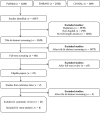Alternate Subthalamic Nucleus Deep Brain Stimulation Parameters to Manage Motor Symptoms of Parkinson's Disease: Systematic Review and Meta-analysis
- PMID: 30746411
- PMCID: PMC6335519
- DOI: 10.1002/mdc3.12681
Alternate Subthalamic Nucleus Deep Brain Stimulation Parameters to Manage Motor Symptoms of Parkinson's Disease: Systematic Review and Meta-analysis
Abstract
Background: The use of alternate frequencies, amplitudes, and pulse widths to manage motor symptoms in Parkinson's disease (PD) patients with subthalamic nucleus deep brain stimulation (STN-DBS) is of clinical interest, but currently lacks systematic evidence.
Objective/hypothesis: Systematically review whether alternate STN-DBS settings influence the therapy's efficacy for managing PD motor symptoms.
Methods: Systematic searches identified studies that; involved bilateral STN-DBS PD patients; manipulated ≥ 1 STN-DBS parameter (e.g., amplitude); assessed ≥ 1 motor symptom (e.g., tremor); and contrasted the experimental and chronic stimulation settings. A Mantel-Haenszel random-effects meta-analysis compared the UPDRS-III sub-scores at low (60-Hz) and high frequencies ( ≥ 130 Hz). Inter-study heterogeneity was assessed with the Cohen's χ2 and I2 index, while the standard GRADE evidence assessment examined strength of evidence.
Results: Of the 21 included studies, 17 investigated the effect of alternate stimulation frequencies, five examined alternate stimulation amplitudes, and two studied changes in pulse width. Given the available data, meta-analyses were only possible for alternate stimulation frequencies. Analysis of the heterogeneity amongst the included studies indicated significant variability between studies and, on the basis of the GRADE framework, the pooled evidence from the meta-analysis studies was of very low quality due to the significant risks of bias.
Conclusions: The meta-analysis reported a very low quality of evidence for the efficacy of low-frequency STN-DBS for managing PD motor symptoms. Furthermore, it highlighted that lower amplitudes lead to the re-emergence of motor symptoms and further research is needed to understand the potential benefits of alternate STN-DBS parameters for PD patients.
Keywords: DBS; STN; UPDRS; low‐frequency stimulation.
Figures


References
-
- Silberstein P, Bittar RG, Boyle R, et al. Deep brain stimulation for Parkinson's disease: Australian referral guidelines. J Clin Neurosci. 2009;16(8):1001–1008. doi: 10.1016/j.jocn.2008.11.026. - PubMed
-
- Fasano A, Romito LM, Daniele A, et al. Motor and cognitive outcome in patients with Parkinson's disease 8 years after subthalamic implants. Brain. 2010;133:2664–2676. doi: 10.1093/brain/awq221. - PubMed
-
- Rodriguez‐Oroz MC, Moro E, Krack P. Long‐term outcomes of surgical therapies for Parkinson's disease. Mov Disord. 2012;27(14):1718–1728. doi: 10.1002/mds.25214. - PubMed
-
- Fasano A, Aquino CC, Krauss JK, et al. Axial disability and deep brain stimulation in patients with Parkinson disease. Nat Rev Neurol. 2015;11(2):98–110. doi: 10.1038/nrneurol.2014.252. - PubMed
-
- Moreau C, Defebvre L, Destee A, et al. STN‐DBS frequency effects on freezing of gait in advanced Parkinson disease. Neurology. 2008;71(2):80–84. doi: 10.1212/01.wnl.0000303972.16279.46. - PubMed
Publication types
LinkOut - more resources
Full Text Sources

